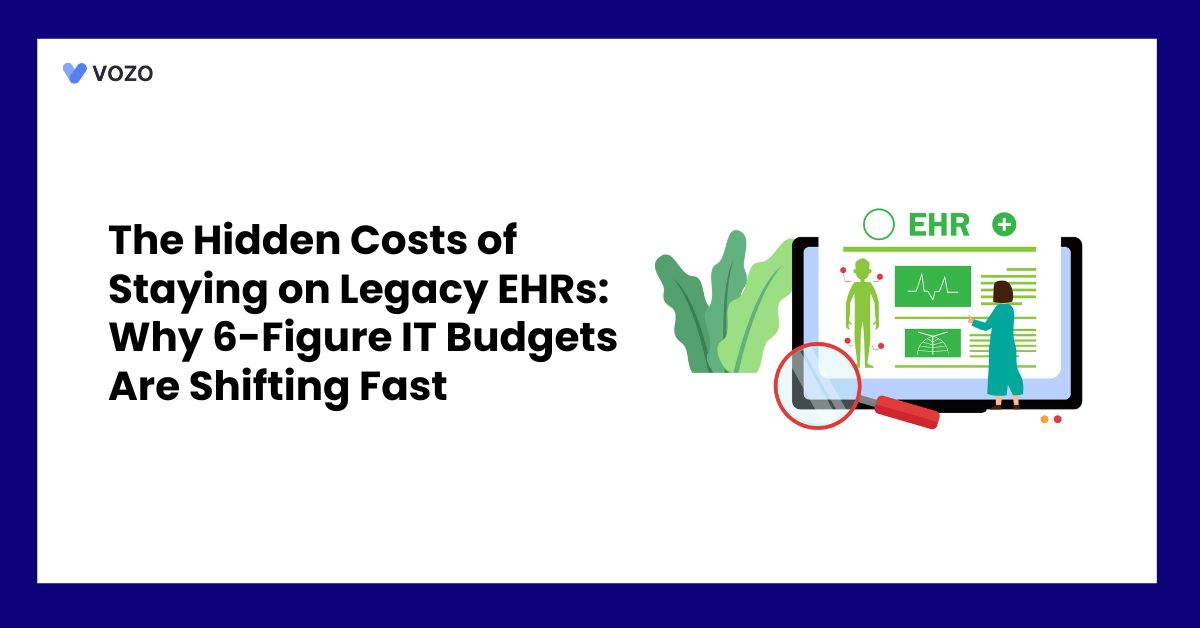The Hidden Costs of Staying on Legacy EHRs: Why 6-Figure IT Budgets Are Shifting Fast
Many hospitals and practices still rely on legacy Electronic Health Record systems – older, on-premises platforms installed years ago. These systems often formed the backbone of care delivery but have since fallen behind today’s standards. A report found that roughly 60% of healthcare organizations still use legacy systems for critical functions.
Organizations cling to these entrenched EHRs for various reasons: massive initial investments, complex data migrations, vendor lock-in, and the risk of service disruptions make change daunting. However, remaining on an outdated EHR comes with hidden costs. In an era of agile cloud platforms and value-based care, the expense of inaction is mounting.
Hidden Costs of Legacy EHRs
Legacy EHRs impose a range of hidden burdens on healthcare IT budgets and clinical operations. Under the hood, aging systems require far more work to keep running and rarely deliver the flexibility needed for modern care. The following challenges illustrate why “if it ain’t broke” isn’t enough justification for maintaining outdated software:
1. High Maintenance Overhead
Legacy EHRs generally consume the majority of IT budgets. According to industry data, firms might spend up to 75% of their IT expenditure supporting old systems.
Every year, IT teams must apply endless patches, source rare replacement parts, and manually upgrade server infrastructure – costs that typically exceed what most buyers anticipate. In practice, this drains funds that could instead be used for innovation or new services.
2. Integration Headaches
Older EHRs usually lack modern interoperability standards. As a result, connecting them to new tools or data sources becomes a custom-engineering project.
A HIMSS survey found that 71% of providers reported significant difficulty integrating legacy systems with new health IT initiatives. Each new interface or workaround adds time and expense. Data often remains siloed, making it hard to form a single patient record and hindering innovations like AI analytics or telehealth.
3. Poor Usability and Clinician Burnout
Many legacy EHRs were designed more for billing than for ease of use. Clinicians often describe them as clunky or non-intuitive. Studies show that U.S. physicians spend roughly half their workday on EHR or desk work rather than on direct patient care.
Cumbersome workflows and “click-heavy” interfaces frustrate staff and slow down rounds. Poor usability is a key driver of provider burnout and turnover, which in turn costs the organization millions in lost productivity and re-training.
4. Staff Training Burden
Legacy systems frequently require specialized knowledge. As experienced staff retire or move on, their “tribal knowledge” goes with them. Onboarding new clinicians and IT staff on old EHR quirks can be time-consuming and costly. One analysis notes that training on legacy EHRs demands “significant time and resources,” because each new hire must learn dated workflows and unsupported modules.
Moreover, outdated user interfaces often force longer ramp-up periods. This ongoing training overhead further inflates the true cost of legacy platforms.
5. Security and Compliance Risks
Unsupported or unpatched legacy software is a magnet for cyberattacks. Vulnerabilities in old EHRs have been linked to many data breaches. For example, the Ponemon Institute found 83% of healthcare organizations experienced a breach in the past two years, many due to legacy system flaws.
Breaches and downtime can incur huge financial penalties and harm a hospital’s reputation. Hospitals must scramble to secure aging servers and maintain compliance on their own, since vendors may no longer provide updates or support.
Related: EHR Security: A 2025 Playbook for HIPAA, HITECH & Cloud Compliance
6. Patient Care Delays and Inefficiencies
Ultimately, legacy EHR problems ripple to patient care. When systems are slow or crash, clinicians can’t retrieve or document critical information quickly.
- One study found that lab test results were delayed by about 62% during unexpected EHR outages.
- Each minute of downtime is expensive and potentially dangerous – estimates put the average cost of a single minute of hospital IT downtime at roughly $7,900.
- Delays from system failures lead to longer patient wait times, cancelled appointments, and even duplication of tests.
These inefficiencies can degrade the quality of care and patient satisfaction, further underscoring the high “hidden” price of legacy systems.
How Modern Cloud EHRs Solve These Problems
Modern cloud-based EHR platforms are designed to eliminate these hidden costs by delivering efficiency, interoperability, and continual innovation:
1. Lower Maintenance, Higher ROI
Cloud EHR vendors absorb most of the maintenance burden. Updates, patches, and hardware maintenance are handled behind the scenes and delivered automatically.
- As PwC observes, moving core applications like EHRs to the cloud can “reduce operational risks” and significantly “lower total cost of ownership”.
- Instead of dedicating 75% of the IT budget to upkeep, organizations pay predictable subscription fees and free their teams to focus on upgrades that improve care.
2. Built-in Interoperability
Cloud EHRs often come with hundreds of ready-to-deploy integrations for telehealth, analytics, patient portals, and devices. PwC highlights that legacy on-premises setups struggle to handle these apps without causing downtime.
By contrast, cloud systems are architected for integration: data flows automatically between modules and with partner systems, eliminating the costly one-off interfaces that legacy users endure. This real-time connectivity means clinicians get a unified patient view without manual chart hunting.
3. Intuitive User Experience
Vendors invest heavily in user-centered design for modern EHRs. Clinicians can access data via optimized web or mobile interfaces with features like voice dictation, AI-assisted decision support, and dashboards. Nurses and doctors now check medications and charts on smartphones and tablets, speeding charting and rounds.
Better UX reduces clicks per task and has been shown to cut burnout. Training time shrinks when interfaces match clinician needs, so staff get up to speed faster.
4. Enhanced Security and Compliance
Leading cloud platforms offer enterprise-grade security far beyond what most individual hospitals can deploy on-premise. They include automated encryption, identity management, continuous backup, and real-time monitoring as part of the service. Compliance controls come out of the box.
Modern EHR suppliers benefit from extensive cybersecurity resources through partnerships with large cloud providers. This shared-responsibility model reduces the likelihood of hospitals missing a critical update or failing a HIPAA audit. In short, cloud EHRs incorporate safeguards that older systems frequently lack.
5. High Availability and Disaster Recovery
Cloud architectures are inherently resilient, with data replicated across multiple data centers. If one server fails, another takes over instantly. This translates to dramatically less downtime compared to a single hospital server rack. Around-the-clock access also means clinicians can review charts and enter orders from anywhere, vital during emergencies or remote work.
By contrast, legacy on-prem EHR downtime can halt admissions and cause backlogs. Modern cloud EHRs generally offer much higher uptime SLAs, so patient care flows uninterrupted.
6. Scalable and Future-Proof
Because they run on elastic cloud infrastructure, modern EHRs can scale to support new data types and users easily. Health systems can spin up new modules without ripping out the database.
This agility means innovations like real-time patient monitoring or genomic decision support become feasible. In short, cloud EHRs unlock the door to next-gen capabilities that legacy systems simply can’t handle without massive overhauls.
6-Figure Budgets Are Shifting Fast
With these challenges and solutions in clear view, many healthcare CIOs are reallocating their six-figure IT budgets. Across the industry, digital and IT spending is surging.
Recent surveys show more than 85% of U.S. health systems increased their IT budgets for 2024, with EHR modernization identified as a top priority by 46% of executives.
- Over the past five years, average budgets for digital health programs grew by about 18%.
- Cybersecurity, EHR/cloud initiatives, and AI/analytics are among the key areas absorbing this funding. In practice, dollars once spent on legacy maintenance are being diverted to cloud migrations, UX improvements, and data-sharing projects.
The message from peers and analysts is clear: clinging to outdated EHRs is no longer cost-effective. Adopting a modern cloud EHR can save money in the long run by cutting support costs and enabling new revenue-generating services.
Health systems that modernize find they can do more with the same budget – improving efficiency without endless hardware refreshes. In short, the financial trend is shifting: organizations that invest now reap gains in both the near term.
Vozo EHR for your Healthcare Practices
From managing and organizing patient health records digitally to reducing medical errors, it significantly empowers providers to improve healthcare quality.
If you are searching for the best EHR system for your healthcare practice, Vozo EHR can be your go-to choice. Our comprehensive EHR solution lets you focus more on patient care while carrying all the burdens and simplifying them.
- Vozo Cloud EHR’s cost-effective cloud subscription benefits all levels of practice.
- Our feature-rich EHR helps you rectify mistakes efficiently and speed up the process.
- Vozo Specialty EHR resonates with specialty practice needs and requirements.
- Our expert technical team has got you covered 24/7 if any needs arise.
- Our EHR System continues to scale as your healthcare practice grows to improve the user experience.
The Vozo Customized EHR solution benefits your healthcare practice by:
- Streamlining the administrative process
- Improving workflow efficiency
- Reducing proneness to errors
- Managing all the patients’ records in one place
- Offers greater efficiency and cost savings across the board.
Our specialty-specific tools, such as scheduling, patient portals, lab integration, cloud hosting, and more, meet the specific needs and requirements of your healthcare practice.
“Embrace Vozo EHR to reduce your burdens and enhance patient care.”
About the author

With more than 4 years of experience in the dynamic healthcare technology landscape, Sid specializes in crafting compelling content on topics including EHR/EMR, patient portals, healthcare automation, remote patient monitoring, and health information exchange. His expertise lies in translating cutting-edge innovations and intricate topics into engaging narratives that resonate with diverse audiences.













